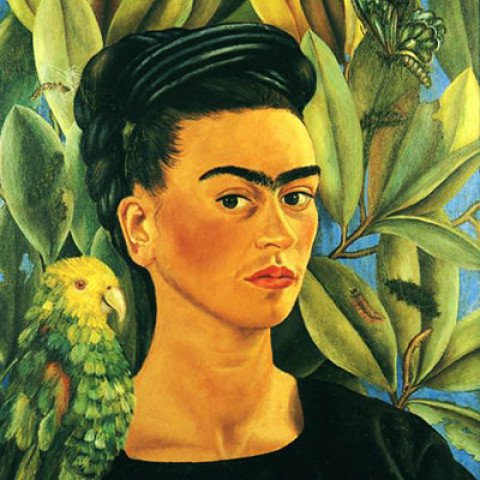Frida Kahlo was born on July 6, 1907 in Mexico City. Her real name was Magdalena Carmen Frida Calderon; she was the daughter of a German Jewish father and a Mexican mother. She lived her adult life in the shadow of her husband, Diego Rivera, the muralist who was a Mexican national hero. She had known him since childhood and when he divorced his second wife, they embarked on a violent courtship.
Both were temperamental and noisy Communists; she proudly pointed out that she had never been expelled from the party as Diego was. He was gross (300 lbs.) and psychologically abusive (he seduced her younger sister, for instance). But the bisexual Frida retaliated with affairs of her own (with Leon Trotsky, for one, and the sculptor Isamu Noguchi, and even some of the women with whom Rivera was dallying).
Kahlo once called Rivera "the other accident" in her life, and she lamented her inability to possess him completely. A grisly accident occurred when she was a teenager: A streetcar hit the bus in which she was riding and drove a handrail into her abdomen and out her vagina. As a result her pregnancies resulted in miscarriages and abortions. Semi-crippled and in constant pain, she required several ghastly operations and enough liquor to make her a probable alcoholic.
She was extremely loyal to her country; she altered her birthdate to coincide wth the start of the 1910 Mexican Revolution, and to her politics; at her cremation a hammer and sickle was draped over the casket. She didn't enjoy a long enough career to make it into the coffee-table books while she she was still alive.
In 1939, after Kahlo returned to Mexico after some success with exhibitions of her work in Paris and New York, she and Rivera divorced. Her health deteriorated, yet she continued to paint. She and Rivera remarried in 1940, but her physical condition worsened. After her death she was transformed from the "wife of Diego Rivera" to the art world's version of Sylvia Plath! The resurrection of Kahlo stated in the 1970s, when her work began to generate excitement in the women's liberation movement. But there always has been much controversy about the worth of her work. She was hailed by the Surrealists and unabashedly admired by Picasso; yet in Mexico itself there are many who feel she is over-rated.
She is the subject of numerous biographies, exhibitions and documentary films, not to mention souvenir T-shirts, calendars and posters. For women and feminists, especially, she is a heroine who overcame great odds to create an identity for herself in art. She died in 1954.
Sources include:
Peter Plagens in "Newsweek Magazine" May 27, 1991
"ARTnews, April 1994 and March 1991
'The Blue House' by Dana Micucci in "Art and Antiques", October 1994
"Time" magazine, April 27, 1953
askart.com

